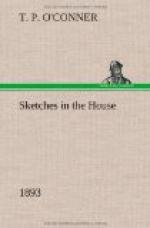place; when night is advanced, the knot is always
about half across Mr. Gladstone’s neck.
On the other hand, he is nearly always very carefully
dressed; his black frock-coat—a little ancient
in make, and always of the smooth black, which has
given way with younger men to the diagonals—is
a well-known feature of every great debate, and adds
grace to his appearance and delivery. When summer
comes, however, he bursts into an almost dazzling
glory of white waistcoats, grey cashmere coats, and
hats of creamy-yellow whiteness, ethereal and almost
aggressively summery. The younger men are not
slow to follow so excellent an example—though
generally there is the tendency to the dark grey, which
is a compromise between the black of winter and the
fiery white tweed which the man in the street is wont
to wear. Sir Charles Russell—who,
returning from Paris on the same day as Mr. Sexton,
received a very warm welcome—is also a
child of his age in his clothes. Time was when
a great legal luminary—especially if he
were on the bench—was supposed to be violating
every canon of good taste if he did not wear garments
which might be described as a cross between the garb
of a bishop, an undertaker, and a hangman. The
judge on the bench, in fact, was always supposed to
be putting on the black cap figuratively, and, therefore,
was obliged to bear with him the outward sign of his
damnable trade. The late Lord Cairns was the
first to break through this tradition, and affect
the style of the prosperous stockbroker. Sir Charles
Russell is different, for he dresses in thorough taste;
but when one saw him in the House of Commons in a
grey suit and a deep-cut waistcoat, one might have
taken him for a gentleman squire with a taste for study,
varied by an occasional visit to Newmarket.
[Sidenote: Mr. Morley’s tweed suit.]
All these observations have been suggested by the
portentous fact that on June 15th Mr. John Morley
startled the world of Parliament by appearing in a
very neat, a very well cut, and a very light tweed
suit. If Mr. Morley figures in many Tory imaginations
as a modern St. Just, longing for the music of the
guillotine and the daily splash of Tory and orthodox
blood, it is much more due to his clothes than to his
writings; for ordinarily he is dressed after the fashion
which one can well suppose reigned in the days when
the men of the Terror were inaugurating a reign of
universal love, brotherhood, and peace through the
narrow opening between the upper and the lower knife
of the guillotine. His coat is blue: so
is his waistcoat; and his nether garments are of a
severe drab brown. It is impossible to imagine
that any man who assumes such garments could be otherwise
than a severe and sanguinary doctrinaire, anxious
for his neighbours’ blood. The genial smile
with which the House of Commons has become familiar
has invalidated the Tory estimate of Mr. Morley, but
it was that memorable Thursday that completed the
transformation of judgment. No man could be a




